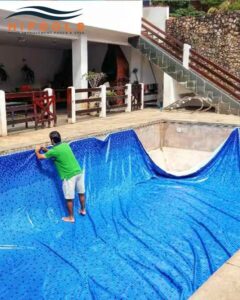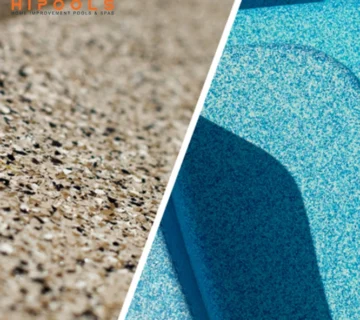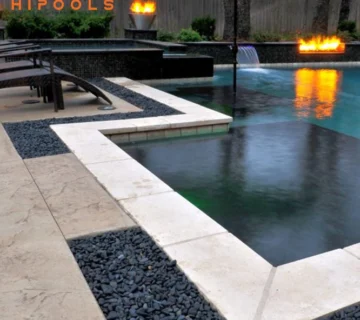A backyard pool promises endless summer fun, but choosing between inground and above-ground options can feel overwhelming. While inground pools offer luxury and permanence, above-ground pools provide affordability and flexibility. This guide breaks down costs, installation, aesthetics, and long-term value—so you can make an informed decision. Plus, discover how Hi Poolss Company simplifies the process with expert guidance tailored to your lifestyle.

1. Installation Process and Timeline
Inground Pools:
– Process:
– Requires excavation, permits, and professional installation (6–12 weeks).
– Professional oversight ensures compliance with safety standards and local building codes.
– Complexity:
– Involves plumbing, electrical work, and landscaping integration.
– Skilled labour is essential to handle technical challenges like waterproofing and structural integrity.
– Example:
– Fiberglass shells streamline installation (8 weeks), while concrete’s curing process extends timelines to 3–6 months.
– Delays often arise from weather, inspections, or material availability.
Above Ground Pools:
– Process:
– Minimal excavation; DIY-friendly setup (1–3 days).
– No major construction needed, making it ideal for quick, budget-conscious projects.
– Flexibility:
– Temporary structures can be disassembled or relocated.
– Perfect for renters or homeowners seeking short-term solutions.
– Example:
– Steel-frame pools with vinyl liners can be operational in a weekend.
– Assembly focuses on leveling the ground and securing the frame, avoiding complex permits.
Note Tip: Local permits may still apply for above ground pools, especially for larger sizes or deck additions.
Cost Comparison: Upfront and Long-Term Expenses
Inground Pools:
The upfront cost of inground pools ($30,000–$70,000+) reflects their permanent, high-end nature. Materials like concrete, fiberglass, or vinyl dictate price variations, with concrete often at the top due to customization and labor-intensive installation. Long-term expenses include higher maintenance, such as frequent chemical balancing, energy-hungry filtration systems, and periodic resurfacing (every 10–15 years for concrete). These ongoing costs stem from their complex infrastructure, which demands professional upkeep to preserve structural integrity and water quality.
Above Ground Pools:
Above ground pools are far more budget-friendly upfront ($1,500–$10,000), with steel, resin, or inflatable models offering plug-and-play simplicity. However, their lower initial investment comes with recurring costs: vinyl liners degrade over time, requiring replacement every 5–10 years ($500–$2,000 per swap), and seasonal setup/takedown adds labor. Their lightweight construction also means higher vulnerability to wear, leaks, and weather damage, which can shorten their lifespan compared to inground options.
Hidden Fees:
Even with upfront quotes, hidden costs can surprise homeowners. For inground pools, landscaping ($5,000–$15,000) is often needed to blend the pool into your yard, while sloped terrain may require retaining walls to prevent erosion. Above ground pools often necessitate add-ons like custom decking ($2,000–$10,000) for accessibility or fencing to meet safety codes—expenses that can double the initial budget. Both pool types may also face permit fees, soil testing, or utility adjustments, emphasizing the need for thorough planning and transparent contractor quotes.
Aesthetic Appeal and Customization
Inground Pools:
Inground pools excel in aesthetic versatility, offering limitless design possibilities like freeform shapes, vanishing edges, and luxe finishes such as glass tile or natural stone. These pools can be tailored to mirror your home’s architecture or landscape, creating a seamless extension of your outdoor living space—think integrated patios, waterfalls, or fire features. Their permanent, built-in nature elevates curb appeal, often becoming a focal point that enhances property value and blends effortlessly with gardens or entertainment areas.
Above Ground Pools:
Above ground pools prioritize function over form, with standard shapes (round or oval) and basic vinyl liner patterns that lack high-end customization. However, creative DIY upgrades—like wraparound decks, ambient lighting, or planter boxes—can mask their utilitarian look. While they’ll never match the elegance of inground designs, strategic additions transform them into inviting retreats, proving that even temporary structures can achieve charm with effort and imagination.
Why It Matters: Aesthetic choices impact both daily enjoyment and resale potential. Inground pools cater to those seeking luxury and cohesion, while above ground pools appeal to budget-minded homeowners willing to trade customization for flexibility.
Durability and Maintenance
Inground Pools:
Inground pools, particularly those made of concrete, boast impressive longevity, often lasting 20–50+ years with proper care. Their durable construction—whether concrete, fiberglass, or vinyl—withstands harsh weather and heavy use, making them a permanent fixture in your backyard. However, this durability comes with ongoing maintenance: weekly cleaning to remove debris, regular pH balancing to protect equipment and swimmers, and periodic resurfacing (every 10–15 years for concrete) to repair cracks or surface wear. While maintenance demands effort and cost, the payoff is a decades-long investment that retains functionality and aesthetic appeal.
Above Ground Pools:
Above ground pools, with steel or resin frames, have a shorter lifespan of 7–15 years, even with liner replacements every 5–10 years. Their lightweight materials are prone to wear from UV exposure, corrosion, or shifting ground. Maintenance focuses on practicality: winterizing to prevent freeze damage, frequent algae prevention due to smaller water volume, and vigilant liner care to avoid punctures from pets, sharp objects, or debris. Though less labor-intensive than inground pools, their temporary nature means recurring costs and eventual replacement, balancing affordability with the need for vigilant upkeep.
In short, inground pools demand higher maintenance for long-term rewards, while above ground pools offer simplicity at the cost of longevity. Your choice hinges on balancing upfront effort with lasting value.
Space and Landscape Considerations
Inground Pools:
Inground pools demand significant space and permanent modifications to your property. They require a large, flat yard to accommodate excavation, plumbing, and landscaping integration, making them impractical for sloped or compact lots. The installation process alters your landscape permanently—think retaining walls, patios, or reshaped gardens—which can limit future yard redesigns. However, this permanence is ideal for homeowners committed to long-term luxury, as inground pools become a seamless extension of outdoor living spaces, enhancing both functionality and visual harmony.
Above Ground Pools:
Above ground pools thrive in smaller or irregularly shaped yards, offering flexibility where space is limited. Their modular design requires minimal groundwork, and they can be installed on uneven terrain with simple leveling. Best of all, they’re temporary: if you move, redesign your yard, or outgrow the pool, disassembly is straightforward. This makes them a smart fit for renters, budget-conscious buyers, or families testing the waters of pool ownership before committing to a permanent investment.
The Bottom Line: Inground pools transform your landscape into a tailored retreat but require space and permanence. Above ground pools adapt to your current needs, offering versatility for evolving lifestyles or constrained budgets. Your choice depends on how much space you’re willing to dedicate—and how deeply you want to root your backyard oasis.
Resale Value Impact
Inground Pools:
Inground pools can significantly enhance your home’s resale value, particularly in warm climates where outdoor living is a lifestyle priority. They often yield a 5–7% return on investment (ROI), appealing to luxury buyers seeking move-in-ready amenities like custom designs or integrated spas. In competitive markets, a well-maintained inground pool can set your property apart, positioning it as a premium offering. However, in colder regions or neighborhoods where pools are less common, the ROI may dip, as some buyers view pools as high-maintenance liabilities.
Above Ground Pools:
Above ground pools rarely boost home value and may even deter buyers concerned about safety, maintenance, or aesthetics. Their temporary nature, however, offers flexibility: they can be disassembled and removed to align with buyer preferences, eliminating the cost and hassle of filling in a permanent structure. This makes them a low-risk option for sellers who want to market a blank slate or cater to families seeking affordability over luxury.

Safety and Accessibility
Inground Pools:
Inground pools require strict adherence to safety regulations, including fencing, self-latching gates, pool covers, and alarms to prevent accidents and meet local codes. Their design allows for accessible entry options like gradual steps, built-in ladders, or beach-style slopes, catering to children, elderly users, or those with mobility challenges. While these features enhance usability, they also add to installation costs and ongoing maintenance.
Above Ground Pools:
The elevated walls of above ground pools naturally reduce accidental falls, but safe access depends on sturdy ladders or lockable steps. Removable ladders can be stored when the pool isn’t in use, adding a layer of child safety. However, their height can make entry difficult for younger kids or pets without supervision. DIY upgrades like locking deck gates or reinforced railings further mitigate risks, balancing convenience with security.
Why It Matters: Safety and accessibility directly impact insurance rates, legal compliance, and buyer confidence. Inground pools demand proactive measures to protect users, while above ground pools prioritize practicality but require vigilance to maintain safe access.
How Hi Poolss Company Helps You Choose Wisely
Still unsure? Hi Poolss Company offers:
– Free Consultations: Assess your yard, budget, and goals to recommend the best fit.
– 3D Design Mockups: Visualize inground pool options or above ground upgrades.
– Flexible Financing: $0-down plans or low-interest loans for any pool type.
Cost-Saving Insight: Opt for energy-efficient pumps (inground) or resin frames (above ground) to reduce long-term costs.
Make a Splash with Confidence
Your ideal pool depends on budget, lifestyle, and long-term plans. Inground pools deliver luxury and permanence, while above ground pools offer affordability and adaptability. Whichever you choose, Hi Poolss Company ensures a seamless process—from design to installation—with warranties and support you can trust.
📞 Ready to Transform Your Backyard? Call Hi Poolss Today at (678) 333-1792 for a Free Quote!




No comment